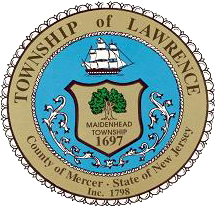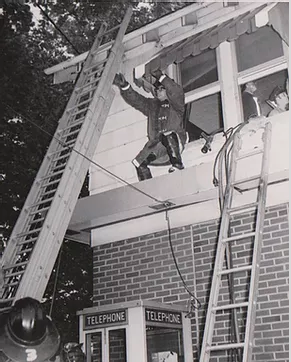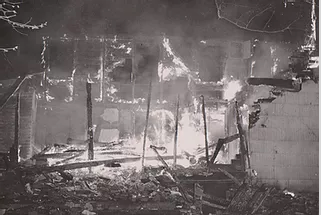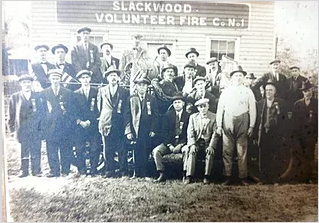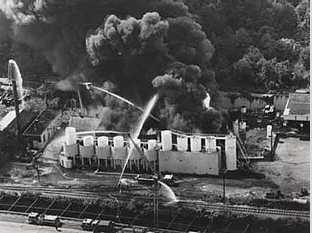Slackwood Fire Company History
Slackwood Fire Company Home Page
History
(From www.slackwoodfirecompany.org/history)
| The Slackwood Fire Company was the first of Lawrence Township's three volunteer fire companies to organize. On November 1, 1906, twenty-seven citizens of the Slackwood area met for the first time. Morgan Van Hise made a motion to form the company and it was passed. They would meet every Thursday at the Slackwood Chapel and dues were set at 10 cents a month. On March 16, 1907, the new company was officially incorporated. George Ford was elected the first chief in September that same year. The first fire apparatus of the new company was a hand-pulled 40-gallon chemical tank built by Valentine Weeden of Princeton Avenue. It cost $600.00 which was expensive at that time. A lot was purchased on Slack Avenue, only a narrow dirt road then, and is the location where the present firehouse now stands. A firehouse was erected by the members to house the one piece of equipment. The Pennsylvania Railroad presented the company with an 800-pound steel locomotive wheel ring to be used by the company as a gong to summon firemen when a fire was reported. As the Slackwood area grew, so did the fire company. In 1914, a second-hand chassis was purchased and equipped with a 200 GPM pump. It was not until January 29, 1916, that a letter was sent to the Lawrence Township Committee asking for official recognition from the town. It was not long before the need for a larger firehouse became obvious, and in 1921, additional land was purchased and a two-story, two-stall building was erected at a cost of $8,000.00. In 1925 a new 500 GPM pump truck was purchased for $6,000,00 and remained in service until 1965 when the first closed cab truck was added. Also in 1925, a Ladies Auxiliary was organized, and the ladies were active in helping the firemen raise money necessary to install a siren on the roof of the firehouse in 1926. Since that time, the Auxiliary has continued to give moral and financial support to the present day. The siren at the firehouse is still operational and used on occasions, but in 1962, a radio tone alerting system was purchased for members to place in their homes which gave out an audible signal and the location of the fire. Small individual pagers have since been provided to all volunteers, sending a signal wherever they may be. Portable radios have also been added to the communication system and are very important parts of the fire fighting operation. Fundraising is an on-going activity with the company, and vital in order to meet the many expenses to keep the company operating. As mentioned previously, the Ladies Auxiliary has always been a partner in the undertakings, and the company takes pride in the fact that they have always worked diligently to pay off their building expansions and have never called upon the Township to help pay off their mortgages. Carnivals were the first of the fund-raisers in the early years, and most recently Bingo games are held each Monday night and are very successful. In 1934, minstrels were held at the Trenton War Memorial. One of the current principal sources of revenue is the annual fund drive conducted within the district. Lawrence Township also provides an annual subsidy, and the use of the hall is frequently rented for social and community activities. The darkest day in the history of the Slackwood Fire Company occurred just before midnight on January 30, 1934, as firemen responded to the fire alarm. Seven young firemen were riding the truck driven by John Moreton as it left the firehouse and pulled onto Brunswick Pike in second gear. Joseph Smith of Cherry Tree Lane was sent out in advance of the engine to flag traffic and warn approaching vehicles, but the driver of a tractor-trailer, traveling northbound on Brunswick Pike, failed to see the flagman in the roadway and struck the fire truck broadside with a splintering crash that was heard over a mile away. The force of the impact was so great the fire truck spun around three times propelling all the firemen into the highway. George H. Combs and Howard Grant were killed instantly, and Frederick R. Turner and Walter O. Penrod died at McKinley Hospital (now Helene Fuld Hospital) several hours after the crash. The driver, John Moreton, who had been trapped underneath the fire truck succumbed at the hospital the following day. George Hancock and Wesley A. Gronikowski were admitted to the hospital and treated for multiple injuries, but survived. Gronikowski became a police officer in the township several years later, retiring in the late 1950s. Ironically, the fire to which the volunteers responded was a grass fire that burned itself out in the meantime. The firemen that rode the truck in the tragedy had been at the firehouse when the alarm came in, but other members, including Chief James Smith, may have been saved by the fact that a high wind muffled the sound of the siren and carried it away from the homes of many of the firemen. A monument in memory of the victims of the tragedy has been erected on Slack Avenue alongside the firehouse. There have been a number of large and dangerous fires that Slackwood has been called to battle over the years. Among them were the Muelhausen Barrel Factory in 1937, the Nassau Diner, Ventura's Tomato Pie Restaurant, Heavy's Scrapyard, Panelyte Corporation, Trenton Frozen Foods, and one of the largest and most dangerous of all, Saturn Chemical Corporation on New York Avenue. That fire broke out on August 21, 1981, at 2:30 PM and by nightfall was extinguished in spite of the threat of chemicals stored there. They also responded to the largest fire in the history of Trenton, when the Trenton Civic Center burned in August 1975. The most recent was the Park Lane / Koos Brothers Furniture Co. at the Lawrence Shopping Center. There have been injuries over the years as the volunteers responded to fires, and in addition to the men that were killed in the 1934 accident, two other firemen died while on duty. Walter Lukasewski suffered a fatal heart attack while directing traffic at a fire and in 1936, William Rathbone, while on traffic duty, was struck and killed by a car as he attempted to clear the way for the engines. 1975 was a very busy year for Slackwood. The Ladies Auxiliary celebrated their 50th anniversary in May, and in early summer, heavy rains caused severe flooding in the area. In August they were called to assist the Trenton Fire Department at the Trenton Civic Center fire. Over the Labor Day weekend, the Trenton Water Filtration Plant broke down and Lawrence residents connected to the system were without water. Slackwood once again responded to the crisis. Under the direction of Chief Rudolph Fuessel, they organized one of the most unique systems ever devised in the area. In response to a call for help, fire companies from all over New Jersey and parts of Pennsylvania committed 78 pumper trucks to run hose lines from the southern end of the Elizabethtown Water Company line, near Stony Brook in Princeton, to the Trenton Water Company line at Union Camp Corporation on Princeton Pike. 2,000 gallons of water per minute were pumped from Elizabethtown to supply the areas without water. The volunteers operated the system 24 hours a day until repairs were made to the Trenton filtration plant, which was completed a week later. In 1957, a large addition was added to the existing firehouse in memory of the five members killed in the 1934 accident. The new addition included a hall and kitchen facilities. In 1965, the first closed cab truck was purchased, and in May 1966, the mortgage on the addition was burned. In 1967, as Slackwood celebrated its first fifty years, only one of the original firemen, Herman W. Ranke, remained active as he watched the company grow from one small chemical tank to modern engines with gauges, gears, gadgets, and rows of hoses. In 1978, a new pumper was added and replaced the last open cab engine that had still been in use. |
|
